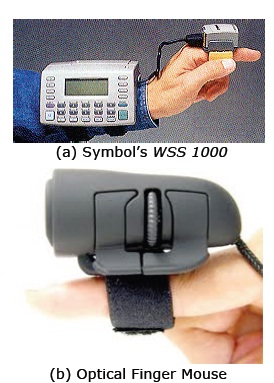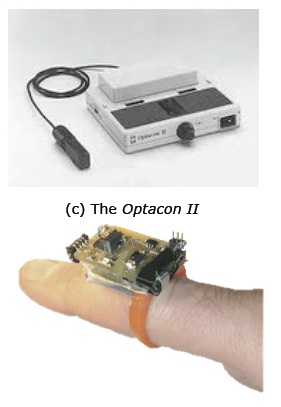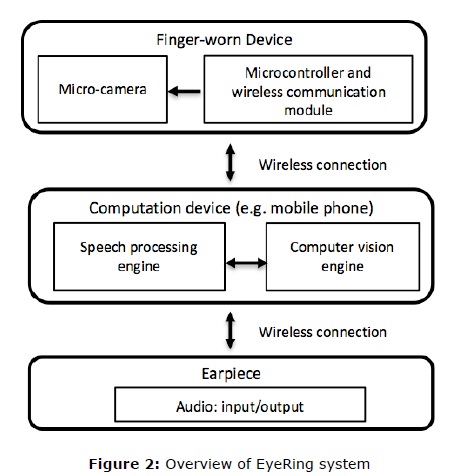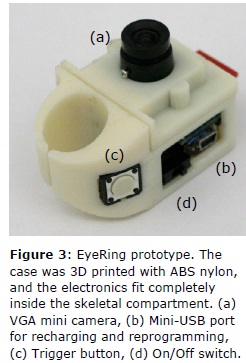





Published on Feb 14, 2025
Finger-worn interfaces are a vastly unexplored space for interaction design. It opens a world of possibilities for solving day-to-day problems, for visually impaired people and sighted people. In this work we present Eye Ring, a novel design and concept of a finger-worn device. We show how the proposed system may serve for numerous applications for visually impaired people such as recognizing currency notes and navigating, as well as helping sighted people to tour an unknown city or intuitively translate signage.
The ring apparatus is autonomous, however it is counter parted by a mobile phone or computation device to which it connects wirelessly, and an earpiece for information retrieval. Finally, we will discuss how finger worn sensors may be extended and applied to other domains.
Despite the attention finger-worn interaction devices have received over the years, there is still much room for innovative design. Earlier explorations of fingerworn interaction devices (some examples are shown in Figure 1) may be divided into a few subspaces according to how they are operated: Pointing [1], [2]; Tapping/Touching [3–5]; Gesturing [3], [6–8]; Pressing/Clicking On-Device [9]. Firstly, we wish to make the distinction between pointing gestures with the finger touching the object and pointing in free air. Our system is based on performing Free-air Pointing (FP) gestures, as well as Touch Pointing (TP) gestures. TP gestures utilize the natural touch sense, however the action trigger is not based on touch sensitivity of the surface, rather on an external sensor. Pointing devices based on TP gestures, as a reading aid for the blind date back to the Optophone and later the Optacon1.
However, the rise of cheap and small photo-sensory equipment, such as cameras, revolutionized the way low-vision people read or interact with visual interfaces. Recently Chi et al presented Seeing With Your Hand [10], a glove apparatus that uses TP gestures. Other assistive devices that are using imaging technology but not TP gestures are Primpo’s iSONIC2 and the i-Cane3 which act both as a white cane and as a visual assistant that can tell the ambient lighting condition and colors of objects. The haptic element of TP gestures is interesting especially in the case of assistive technologies for the visually impaired. This enables them to get additional feedback on the object they want to interact with.

FP gestures on the other hand, are rooted in human behavior and natural gestural language. This was shown to be true by examining gestural languages of different cultures [11]. Usually FP gestures are used for showing a place or a thing in space - a passive action. However, augmenting FP for information retrieval is an interesting extension. Previous academic work in the field of FP gestures, revolved around control [2] and information retrieval [1]. These works and others utilize a specialized sensor, usually an infrared connection, between the pointing finger and the target. This implies the environment to be rigged especially for such interaction. We chose to use a generalized approach by using a general-purpose camera. This choice breaks the bonds of dimensionality of a single signal source or sensor, as well as the bonds of wavelength as it operates in the wider, visible spectrum.

The desire to replace an impaired human visual sense or to augment a healthy one had a strong influence on the design and rationale behind EyeRing. Most of the work around FP and some TP gestures (e.g. the Optical Finger Mouse) are aimed towards sighted people. At the initial stage of this project, we chose to focus on a more compelling aspect of exploring how visually impaired people may benefit from finger-worn devices. In this paper, we describe the EyeRing prototype, a few applications of EyeRing for visually impaired people and some future possibilities. Finally we discuss our plans of extending this work beyond the assistive interfaces domain.
Our proposed system is composed of a finger-worn device with an embedded camera, a computation element embodied as a mobile phone, and an earpiece for information loopback. The finger-worn device is autonomous and wireless, and includes a single button to initiate the interaction. Information from the device is transferred to the computing element where it is processed, and the results are transmitted to the headset for the user to hear. Overview of the EyeRing system is shown in (Figure 2). The current implementation of finger-worn device uses a TTL Serial JPEG Camera, 16 MHz AVR processor, a bluetooth module, 3.7V polymer Lithium-ion battery, 3.3V regulator, and a push button switch.

These components are packaged into a wearable ABS nylon casing (Figure 3). Speech processing engine and computer vision engine were implemented on a mobile phone running Android 2.2. A user needs to pair the finger-worn device with the mobile phone application only once and henceforth a Bluetooth connection will be automatically established when both are running. A visually impaired user indicated this as an essential feature. Typically, a user would single click the pushbutton switch on the side of the ring using his thumb (Figure 4). At that moment, a snapshot is taken from the camera and the image is transferred via bluetooth to the mobile phone. An Android application on the mobile phone then analyzes the image using our computer vision engine. Type of analysis and response depends on the preset mode (color, distance, currency, etc.). Upon analyzing the image data, the Android application uses a Text-to- Speech module to read out the information though a headset. Users may change the preset mode by double- Figure 2: Overview of EyeRing system clicking the pushbutton and giving the system brief verbal commands such as “distance”, “color”, “currency”, etc., which are subsequently recognized.
The task of replacing the optical and nervous system of the human visual sense is an enormous undertaking. Thus, we choose to concentrate on learning the possible interaction mechanics for three specific scenarios outlined in this section.
Compared to a steel cane, a finger-worn device used for navigation is certainly less obtrusive, as well as fashionable and appealing. The essence of this application is to provide an approximate estimation of the clear walking space in front of the holder of the ring. Users must use FP gestures to take pictures of the space in front of them, by pointing the camera and clicking, with some motion between the shots. In a continuous-shooting mode (video), which is currently not supported in our prototype, there is no need for repeated clicking.
The system clearly notifies the approximate free space in front. For this application, we employ the concept of Structure from Motion (SfM). Upon receiving the two images, an algorithm to recover the depth is performed. The general outline of the algorithm is as follows: (a) the two images are scanned for salient feature points and then affine-invariant descriptors are calculated for them, (b) the features in both images are matched into pairs, (c) the pairs are used to get a dense distance map from the location of the camera in the first photo [12], (d) we use a robust method to fit a model of a floor to the data, and return the distance of the clear walking path in front. By repeatedly taking photos with motion, equivalent of moving a steel cane, we check the recovered 3D mapping of the floor and objects for any obstacles in the way of the user. Figure 5 outlines the above process.
This application is intended to help the user to identify currency bills (1$, 5$, 10$, 20$, 100$) to aid with payments. The interaction process is simple; a user would simply point index finger to a currency note (using a TP gesture then moving the finger back) and click the button. The system will voice out what the note is (Figure 6). A detection algorithm based on a Bag of Visual Words (BoVW) approach [13] scans the image and makes a decision on the type of note it sees. We use Opponent Space [14] SURF features to retain color information, for notes detection. Our vocabulary was trained to be of 1000 features long, and we use a 1-vs.-all SVM approach for classifying the types of notes. For training we used a dataset of 800 images using k-fold crossvalidation, and 100 images withheld for testing. As of writing these lines the overall recognition rate is over 80% with a 0.775 kappa statistic.

This application of EyeRing aids a visually impaired person to understand the color of an object. Again, the user interaction is simple; users simply touch point (TP gesture) to an object and click the button on the ring to deliver an image for processing (Figure 7). The system analyses the image and returns the average color via audio feedback. We use a calibration step to help the system adjust to different lighting conditions. A sheet of paper with various colored boxes is printed, and a picture of it is taken. We rectify the region in the image so that it aligns with the colored boxes, and then extract a sample of the pixels covering each box. For predictions we use a normal distribution, set to the maximum likelihood of the perceived color.
EyeRing is still very much a work in progress. Future applications using EyeRing rely on more advanced capabilities of the device, such as real-time video feed from the camera, higher computational power, and additional sensors like gyroscopes and a microphone. These capabilities are currently in development for the next prototype of EyeRing.
Visually impaired people are mostly bound to reading Braille or listening to audio books. However the amount of written material that are in Braille or audio transcribed is limited. The fact remains that natural interaction in our world requires decent visual abilities for reading. This application will allow the visually impaired to read regular printed material using EyeRing. The user simply touches the printed surface with the tip of the finger (TP gesture) and moves along the lines. Naturally, a blind person cannot see the direction of the written lines. For that reason we plan to implement an algorithm to detect the misalignment between the movement of the finger and the direction of the text, correcting the user’s movement using the audio feedback
We plan to extend EyeRing applications to domains beyond assistive technology. For example, tourists visiting a new city often rely on maps and landmarks for navigation. Recently, locationing systems, inertial sensors and compasses in mobile devices, and readily available dense mapping of most major cities, replaced the usage of paper maps. However, even with augmented reality applications such as Layar4, the UI for on-foot navigation is still cumbersome. Our proposed application relies on a much more natural gesture, such as simply pointing at the wanted landmark, asking “What is that?” and hearing its name.
EyeRing suggests a novel interaction method for both visually impaired and sighted people. We choose to base the interaction on a human gesture that is ubiquitous in any language and culture – pointing with the index finger. This has determined the nature and design of the ring apparatus, location of the camera and trigger. The applications we presented for EyeRing emerge from the current design. Preliminary feedback received from a visually impaired user supports that EyeRing assistive applications are intuitive and seamless. We are in the process of conducing a more formal and rigorous study to validate this. One of the biggest challenges is creating the supporting software that works in unison with this unique design. However, we believe that adding more hardware such as a microphone, an infrared light source or a laser module, a second camera, a depth sensor or inertial sensors, will open up a multitude of new uses for this specific wearable design.
[1] Merrill, D. and Maes, P. Augmenting looking, pointing and reaching gestures to enhance the searching and browsing of physical objects. In Proc. Pervasive'07, (2007) 1–18.
[2] Tsukada, K. and Yasumura, M. Ubi-finger: Gesture input device for mobile use. In Proc. APCHI’02, 1 (2002), 388-400.
[3] Lee, J., Lim, S. H., Yoo, J. W., Park, K. W., Choi, H. J. and Park, K. H. A ubiquitous fashionable computer with an i-Throw device on a locationbased service environment. In Proc. AINAW’07, 2 (2007), 59-65.
[4] Fukumoto, M. and Suenaga, Y. ‘FingeRing’: a fulltime wearable interface. In Proc. CHI'94, ACM Press (1994), 81-82.
[5] Fukumoto M. A finger-ring shaped wearable handset based on bone conduction. In Proc. ISWC '05, (2005), 10-13.
| Are you interested in this topic.Then mail to us immediately to get the full report.
email :- contactv2@gmail.com |